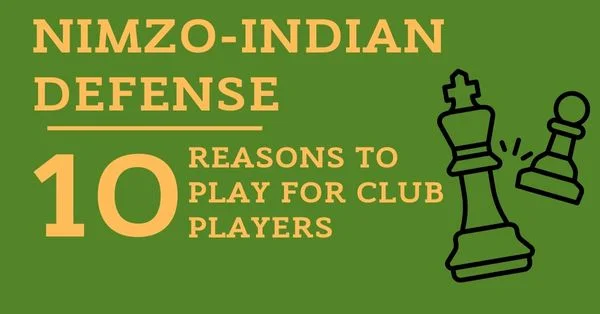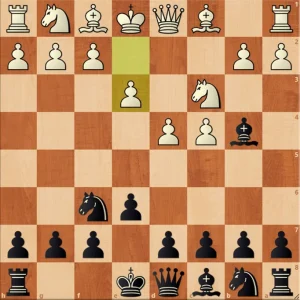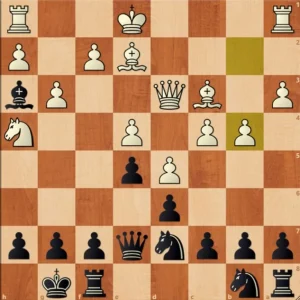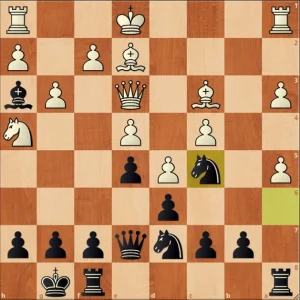Nimzo-Indian Defense: 10 Reasons to Play for Club Players

Nimzo-Indian Defense is named after Aron Nimzowitsch, a Latvian chess grandmaster who was one of the leading players of the early 20th century.
The Nimzo-Indian Defense was first played by Nimzowitsch in the 1920s, and it quickly became a popular opening among top-level players.
The opening is a response to the move 1.d4 by white and begins with the moves 1.d4 Nf6 2.c4 e6 3.Nc3 Bb4.
The Nimzo-Indian Defense was further developed by other chess players in the following decades, including Botvinnik, Smyslov, and Karpov. These players used the opening to great effect, often playing it in world championship matches and other important tournaments.
Over the years, many variations of the Nimzo-Indian Defense have been developed, including the Rubinstein Variation, the Saemisch Variation, and the Classical Variation. Each variation has its unique characteristics and strategic possibilities.
If you are a club-level chess player looking for a solid and flexible defense against 1.d4, the Nimzo-Indian Defense is a great option to consider.
This opening has been a popular choice among top-level grandmasters including Kasparov, Kramnik, and Carlsen for decades and offers a wide range of possibilities for both aggressive and positional players.
Here are 10 reasons why you should consider playing the Nimzo-Indian Defense:
1. Nimzo-Indian Defense is Easy to Learn
Despite its strategic depth, the Nimzo-Indian Defense is relatively easy to learn, especially for players who are familiar with the basics of chess strategy and tactics.
The opening is based on sound strategic principles, such as controlling the center and developing pieces quickly, and many of the key ideas come from well-established chess principles.
2. Nimzo-Indian has Great Attacking Chances
The Nimzo-Indian Defense offers various opportunities for active counterplay, including the possibility of attacking white pawns on the queenside or launching an attack against the white king.
For example, in some lines, black can play for a quick b5 pawn break to create pressure on white’s queen’s wing. In other lines, black may opt for a pawn storm on the kingside, supported by the pieces.
3. Nimzo-Indian Allows for Flexibility in Many Variations
The Nimzo-Indian Defense offers flexibility in terms of pawn structure, piece placement, and strategy. You can choose to play aggressively or positionally, depending on your style and the specific game situation.
For example, in some lines, black can play for a quick e5 pawn break to gain space in the center, while in other lines, black may opt for a more solid and defensive setup.

This position is called the Rubinstein Variation.
Black can employ multiple plans. You can play d5 with firm control over the center or play for a dark square blockade with c5, and d6 and eventually prepare e5 with Qe7 and Nbd7.
This flexibility makes the Nimzo-Indian Defense a great choice for club players who want to improve their strategic skills.
4. Nimzo has a High Winning Percentage Compared to Other 1.d4 Defenses
It has a high winning percentage for black at all levels of play, including among grandmasters.
According to the database, black has a winning percentage of 31.6% in the Nimzo-Indian, compared to 25.4% for the King’s Indian Defense and 23.6% for the Grunfeld Defense. This is a clear indication of the strength and effectiveness of the opening.
5. Allows Direct Play Against the Opponent’s Center
Many defenses against d4 concede the center early in the game and as a result, we have to maneuver a lot to compensate for the lack of space or look for active counterplay to not get crushed immediately. Some variations of this opening are designed to counteract the opponent’s control of the center and provide a solid foundation for the game.
By playing the Nimzo-Indian Defense, club players can gain an advantage in the early stages of the game and put pressure on their opponents.
6. Nimzo is a Popular Opening
It is a popular and well-studied opening, meaning that there is a wealth of resources available to help you improve your play and develop your understanding of the opening.
Many books and online resources are dedicated to the Nimzo-Indian Defense, and it is often played at the highest levels of the game, which means that there are many high-quality games to study and learn from.
7. Black Gets Active Piece Play
It encourages active piece play and allows black to place its pieces aggressively. This can create opportunities for counterattacks and put pressure on white. In many variations, black can also develop their pieces quickly and create threats against the white’s king.
8. Nimzo Helps to Improve Chess Strategy
The Nimzo-Indian Defense offers many strategic possibilities, including the option of playing with a hanging pawn structure, exchanging off pieces to create a favorable endgame, or creating a pawn storm on the kingside.
In some lines, black can play for a quick e5 pawn break to gain space in the center, while in other lines, black may opt for a more solid and defensive setup.

In the following position, Black plays a5. Fighting for the dark squares in the queenside and consequently establishing an outpost on c5 for the knight.

9. Nimzo is Common on the Grandmaster’s Level
The Nimzo-Indian Defense is a popular opening among grandmasters.
This means that there are many high-level games that club players can study to improve their own game. By studying grandmaster games, players can learn new ideas and strategies and apply them in their games.
10. Tons of Lines and Variations to Pick from
The Nimzo-Indian Defense is a popular opening among grandmasters. This means that there are many high-level games that club players can study to improve their own game. By studying grandmaster games, players can learn new ideas and strategies and apply them in their games.
Here are the two extra reasons for you!
11. Nimzo-Indian Teaches Important Chess Principles
The Nimzo-Indian Defense is an opening that teaches important chess principles.
These principles include controlling the center of the board, developing pieces quickly and efficiently, and placing pressure on the opponent’s pieces. By playing the Nimzo-Indian Defense, club players can improve their understanding of these principles and apply them in other games.
12. Allows for aggressive play
While the Nimzo-Indian Defense is a solid and sound opening, it also allows for aggressive play. This is particularly true in some of the variations, such as the Saemisch Variation. By playing aggressively, club players can put pressure on their opponents and force them to make mistakes. This can lead to opportunities for the player to gain an advantage and win the game.
To sum up…
Overall, the Nimzo-Indian Defense is a versatile and powerful opening that has stood the test of time and remains a popular choice among chess players at all levels.
Whether you prefer to play aggressively or positionally, the Nimzo-Indian Defense offers a rich and complex set of possibilities that can lead to captivating games and exciting chess battles.










Comments: